Devi Rajab was good enough to send me a transcript of her article, entitled "Creating a Peaceful Nation," that appeared in the June 4th issue of the Mercury. I've included the transcript here, for those of you who don't subscribe to the paper:
Devi's Diary Monday Column
I had an opportunity to speak with some foreign visitors to our shores recently. A mother and son team Dr Josephine Naidoo an eminent Canadian social psychologist and her son Dr Kenneth Leslie a clinical neuro-cognitive scientist had come to conduct research in SA. Effortlessly the conversation trailed to SA and the crime and its future. Although SA is a microcosm of the world, it is significant that they felt that it displays the most pernicious form of violent crime, which involves shocking acts of cruelty reminiscent of Stanley Kubrick's film "A Clockwork Orange." They cite the example of a white man stripped naked by thugs who then crazy- glued his exercise bike and forced him to sit on it and then sealed his mouth with the same glue and proceeded to rob him. Attacks like these induce fear and revulsion in the population, and lead to a sense of hopelessness and despair. But they also tell a lot about the psyche of the perpetrators, which we need to study closely in order to understand why they do what they do. What follows is a series of questions and answers towards a better understanding of how we could fight crime by building a non-violent society.
Our prisons are overflowing. Lesser criminals become hardened, hardened become irredeemable. Recidivism is high. We spend more money on security than food and criminals are emerging like the proverbial Hydra monster, the more you lop of its head the more heads emerge. How should South Africans respond to ubiquitous crime, I asked. Other than employing private security companies, retreating to gated communities, building walls and electrified fences and filling up our jails with inmates, what should we do? “I have been reading Richard Gregg's "The Power of Non-Violence," which has helped me to better understand the principles of Satyagraha says Dr Lesley. The approach maintains that you cannot solve any problem at the level of the problem. A violent response to thugs only serves to reinforce the idea that problems can be solved through violence. In a sense, you are agreeing with the criminals, that might really does make right. The increased security approach is already showing its limitations, and it is clear that it will never solve the security problem in South Africa, or it might do so by returning South Africa to a police state.”
What about the efficacy of the principal of an eye for an eye as a quick and immediate deterrent I asked provocatively. Many South Africans are calling for the death penalty and cite the Arab method of cutting off limbs as a negative reinforcer. There is very little crime in Muslim countries where merchants leave their goods unguarded while they attend to their ritual prayers. While this may be so there is a great deal of collective violence displayed in the acts of the suicide bombers.
“ Violence begets violence and what we want to create is a society that is truly free and non violent. There is a real opportunity to explore alternative approaches to reducing violent crime in South Africa he said. One such approach would involve a Satyagraha campaign aimed at discrediting the use of violence. After all Gandhiji was also a son of Africa and for 21 years he incubated these ideas on this very soil”.
But surely this is a tall order and out of synch with the dominant culture I asked? Non-violence is wonderful as a philosophy but how do we translate this into some concrete proposals?
”Before we can begin to articulate a plan for a campaign against violent crime, it is important to understand the psychology of our opponent. A vital tool in disarming our opponents is empathy. I would argue that the men who stripped that man of his clothes and crazy glued him to his bicycle seat, have, themselves, suffered from feelings of being emasculated and rendered helpless and voiceless. From this perspective, their violent act can be seen as a tragic attempt to seek empathy, in this case, by victimizing someone else. An important part of our strategy is an attempt to help our opponents remember their humanity (by treating them like human beings instead of enemies), and help them recover their sanity.” Change will hinge on helping people to disengage themselves from their identity as gangsters, and help them instead to realize their own capacity for feelings of vulnerability and love. It is important to remember that this identity is only a persona, and not who the person really is.
Progress will depend in part on getting past enemy imagery, and seeing the humanity of our opponent, but what then?
“ The next step involves identifying opportunities for contact with violent criminals, and then creating situations where the power of non-violence can be used to maximum advantage. South Africa has many violent criminals in prison. Instead of judging these people, and reinforcing their identity as the "worst of the worst," which just plays into their egos, and reinforces a culture of violence and retributive justice, we could instead adopt methods pioneered by Kiran Bedi who reformed the infamous Tihar jail in India which many described as a hellhole and converted prisoners into noble citizens through a course in Vipassana, an ancient technique of self-purification, which has experienced a public revival in India after having been all but lost for centuries. Participants spend a rigorous ten days of meditation and prayer, learning to observe themselves. As the course progresses, the participant is brought face to face with himself. This experience has had a positive impact on many of the prisoners who claim that the course rehabilitated them as it forced them to look directly and without excuses into their dark sides.”
How can we confront violent criminals in a non-violent way that communicates self-respect and respect for the attacker, without taking foolish risks? “The answer will require more research, and I think it will involve Non-Violent Communication, and a delicate balance between asserting one's right to personal and economic safety and a willingness to let go of one's personal possessions. This idea could be extended even further: a willingness on the part of wealthy South Africans to embrace voluntary simplicity and live with less, and instead invest in strategies for making sure that everyone's needs get met, including the need for economic and personal security for all. This, along with access to education and opportunity, can help South Africans create a peaceful and prosperous nation.
 Mum and I visit South Africa in 2007 and 2012 to learn about the life and times of my great grandfather, Vincent Lawrence (1872-1965). Lawrence worked with Gandhi when the Mahatma was in South Africa, got involved in the struggle against apartheid, and helped found St. Anthony's Church in Durban.
Mum and I visit South Africa in 2007 and 2012 to learn about the life and times of my great grandfather, Vincent Lawrence (1872-1965). Lawrence worked with Gandhi when the Mahatma was in South Africa, got involved in the struggle against apartheid, and helped found St. Anthony's Church in Durban.
Wednesday, June 13, 2007
Saturday, June 9, 2007
Letter from Dr. Betty Govinden
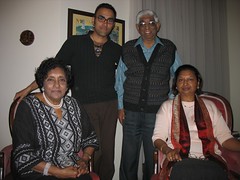 Mum and I did an interview with Herbie and Berry Govinden, before we left South Africa. We also had a chance to discuss with them the application of Satyagraha to South Africa's violent crime problem, and Devi Rajab's recent article in the Mercury (you can see a picture of the article here, and I am trying to make a copy of the article accessible online for free). Here is Dr. Govinden's response to the article, which was recently published in the Mercury, for the record:
Mum and I did an interview with Herbie and Berry Govinden, before we left South Africa. We also had a chance to discuss with them the application of Satyagraha to South Africa's violent crime problem, and Devi Rajab's recent article in the Mercury (you can see a picture of the article here, and I am trying to make a copy of the article accessible online for free). Here is Dr. Govinden's response to the article, which was recently published in the Mercury, for the record:VINCENT LAWRENCE – Role Model for a Great Grandson
I was happy to read Devi Rajab’s account of her dialogue with Dr Kenneth Leslie, who told her of the power of non-violence, as espoused by Gandhi, to deal with the rampant problems of crime [The Mercury, June 4th]. Leslie’s constructive application of Gandhian principles to present-day problems of violence in all forms is worth understanding and following through purposefully both locally and internationally.
Reading the article, I pondered over how Gandhian principles have been handed down from generation to generation. Dr Leslie is the great grandson of Vincent Lawrence, who was Gandhi’s secretary. Lawrence, a well-known community leader at the time, came from Madras in the early 1890’s as a trained teacher, and worked as a clerk in Gandhi’s legal practice in Durban.
He was a part of the Gandhi household for a time and imbibed Gandhi’s values and ideals, as did R K Khan, the well-known advocate and philanthropist. He worked side by side with Gandhi in the Ambulance Corps during the South African War. It is not surprising that Vincent Lawrence spear headed many petitions in the 1900’s against discriminatory laws which affected Indians adversely. Lawrence assumed the leadership of the Natal Indian Congress from time to time and contributed to several social welfare organizations, sporting, cultural and church groups. A devout Catholic, he was staunchly non-sectarian is his dealings, like his mentor. It is worth noting that Leslie’s great grandmother, Mrs Josephine Lawrence served the cause of education and social upliftment, especially that of women and girls.
Even after Gandhi returned to India, Lawrence continued with his political involvement, working with Manilal Gandhi, who himself followed in the footsteps of his father. Lawrence was among Manilal’s key supporters when there were South African solidarity formations in Durban for the Swaraj movement in India.
I would be very interested to know whose copy of Richard Gregg’s “The Power of Non-Violence” Kenneth Leslie is reading. This was one of Manilal Gandhi’s favourite books and was much in use in the early 1950’s when Manilal went on an extended fast in protest against the apartheid government’s policies. It was Vincent Lawrence who readily offered his support to Manilal at the time, as well as, among others, Gadija Christopher.
A great grandfather such as The Honourable Vedanayagum [Vincent] Lawrence - what an admirable legacy for Kenneth Leslie to draw on!
MS D GOVINDEN Phd
Writing for Change
Check out this IDRC sponsored website on effective writing. I continue to be impressed by my copy of "The Power of Non-Violence" by Gregg. His writing is very effective at getting his message across, and I'd like to learn to be similarly effective in developing ideas regarding the application of non-violence to our times, including the use of Non-Violent Communication, and both persuading and teaching people how to strengthen their own non-violent responses to life.
Delegitimizing Violence and Building Peace
I came across this article on Turning the Tide of Violence in South Africa by the Canadian International Development Research Center (IDRC). In part, the article suggests that violence was legitimized as a form of political protest during the apartheid years, even though in many cases, this violence was also economically motivated. How deep does this legitimization go? I was surprised to read Nelson Mandela's comments on Gandhi on the Tolstoy's Farm website. Mandela seems to be at pains to justify the use of violence to combat apartheid. Here is an excerpt:
Gandhi remained committed to nonviolence; I followed the Gandhian strategy for as long as I could, but then there came a point in our struggle when the brute force of the oppressor could no longer be countered through passive resistance alone. We founded Unkhonto we Sizwe and added a military dimension to our struggle. Even then, we chose sabotage because it did not involve the loss of life, and it offered the best hope for future race relations. Militant action became part of the African agenda officially supported by the Organization of African Unity (O.A.U.) following my address to the Pan-African Freedom Movement of East and Central Africa (PAFMECA) in 1962, in which I stated, "Force is the only language the imperialists can hear, and no country became free without some sort of violence."
Gandhi himself never ruled out violence absolutely and unreservedly. He conceded the necessity of arms in certain situations. He said, "Where choice is set between cowardice and violence, I would advise violence... I prefer to use arms in defense of honor rather than remain the vile witness of dishonor ..."
Violence and nonviolence are not mutually exclusive; it is the predominance of the one or the other that labels a struggle.
I disagree with this characterization of Gandhi. I doubt very much that the Mahatma would have endorsed violent opposition to the apartheid Regime. I imagine he would have instead argued for an even more strict application of Satyagraha, which, at its moral core is based on the concept of the application of courage and the acceptance of self-suffering as a tool for awakening the compassion and moral understanding of the oppressor.
It has become a widely accepted truism in South Africa that violence helped end apartheid. I would argue that other factors, such as economic sanctions, sports and scientific boycotts, and the end of the Soviet Union were more important. I believe that the decision to use violence will ultimately be seen as a strategic error, and that the violent wing of the struggle only served to make the regime more repressive, while also contaminating the peace in post-apartheid South Africa.
If the goal of the anti-apartheid struggle was to create racial and economic peace, then the decision to legitimize violence has delayed the realization of that goal, by creating a class of people who are willing to use violence to acquire wealth. This violent criminal activity is working to sabotage South Africa's economic development, and is undermining racial harmony. The solution out of this conundrum is not more law-and-order, and not more security firms, and not the reintroduction of the death penalty! That will only serve to return South Africa to a police state, but with a different master. Instead, a slow and quiet campaign of non-violent resistance to crime, and a compassionate re-education program for convicts are the most effective solutions to realizing the goals of economic peace and racial harmony.
I'd be interested in applying for a grant with the IDRC to develop concrete strategies and pilot projects for transforming violent criminals into Satyarahis. I believe this transformation is possible. As I have developed my own interest in, and understanding of, non-violence, I have realized my own violent tendencies and need to dominate, and through that awareness, relaxed into a more peaceful way of being. The difference between the violent criminals and me is only one of degree, not of kind. That is why I believe this transformation is both possible, and the best hope for economic and racial peace in South Africa.
Gandhi remained committed to nonviolence; I followed the Gandhian strategy for as long as I could, but then there came a point in our struggle when the brute force of the oppressor could no longer be countered through passive resistance alone. We founded Unkhonto we Sizwe and added a military dimension to our struggle. Even then, we chose sabotage because it did not involve the loss of life, and it offered the best hope for future race relations. Militant action became part of the African agenda officially supported by the Organization of African Unity (O.A.U.) following my address to the Pan-African Freedom Movement of East and Central Africa (PAFMECA) in 1962, in which I stated, "Force is the only language the imperialists can hear, and no country became free without some sort of violence."
Gandhi himself never ruled out violence absolutely and unreservedly. He conceded the necessity of arms in certain situations. He said, "Where choice is set between cowardice and violence, I would advise violence... I prefer to use arms in defense of honor rather than remain the vile witness of dishonor ..."
Violence and nonviolence are not mutually exclusive; it is the predominance of the one or the other that labels a struggle.
I disagree with this characterization of Gandhi. I doubt very much that the Mahatma would have endorsed violent opposition to the apartheid Regime. I imagine he would have instead argued for an even more strict application of Satyagraha, which, at its moral core is based on the concept of the application of courage and the acceptance of self-suffering as a tool for awakening the compassion and moral understanding of the oppressor.
It has become a widely accepted truism in South Africa that violence helped end apartheid. I would argue that other factors, such as economic sanctions, sports and scientific boycotts, and the end of the Soviet Union were more important. I believe that the decision to use violence will ultimately be seen as a strategic error, and that the violent wing of the struggle only served to make the regime more repressive, while also contaminating the peace in post-apartheid South Africa.
If the goal of the anti-apartheid struggle was to create racial and economic peace, then the decision to legitimize violence has delayed the realization of that goal, by creating a class of people who are willing to use violence to acquire wealth. This violent criminal activity is working to sabotage South Africa's economic development, and is undermining racial harmony. The solution out of this conundrum is not more law-and-order, and not more security firms, and not the reintroduction of the death penalty! That will only serve to return South Africa to a police state, but with a different master. Instead, a slow and quiet campaign of non-violent resistance to crime, and a compassionate re-education program for convicts are the most effective solutions to realizing the goals of economic peace and racial harmony.
I'd be interested in applying for a grant with the IDRC to develop concrete strategies and pilot projects for transforming violent criminals into Satyarahis. I believe this transformation is possible. As I have developed my own interest in, and understanding of, non-violence, I have realized my own violent tendencies and need to dominate, and through that awareness, relaxed into a more peaceful way of being. The difference between the violent criminals and me is only one of degree, not of kind. That is why I believe this transformation is both possible, and the best hope for economic and racial peace in South Africa.
Simple Living and the Now
The other day I came across this website on simple living. As my opportunities to become rich dwindle, and as my interest in and commitment to non-violence deepens, I find I am becoming increasingly interested in living simply.
Why doesn't everyone live simply? Part of the reason is fear. The fear of lack leads to greed, and the pursuit of material goods, often at the expense of morality, community, and the environment. Is there a way to trust that your needs will get met in the future? Is there a way to be more present, and by so doing, bring compassion and wisdom into everyday life?
E. Tolle suggests that if you are in the now, then you can relax, and just be. Then, whatever action arises out of your response to the now, can come from the core of your beingness. This right action can come from a place of acceptance of 'what is', and a willingness to work with 'what is.' Similarly, there is a Buddhist saying: "There is nowhere to go, there is nothing to do, and there is no one to be." This doesn't mean that we are to be complacent, instead, it means that acceptance, and a spontaneous and compassionate reaction to 'what is,' is sufficient. Another Buddhist technique is to ask yourself "Right now, what is lacking?" By constantly asking this question, you begin to discover that the present is always manageable. Relax. There is no need to worry so much about the future. And there is no need to fret about the past. Just be here now.
Why doesn't everyone live simply? Part of the reason is fear. The fear of lack leads to greed, and the pursuit of material goods, often at the expense of morality, community, and the environment. Is there a way to trust that your needs will get met in the future? Is there a way to be more present, and by so doing, bring compassion and wisdom into everyday life?
E. Tolle suggests that if you are in the now, then you can relax, and just be. Then, whatever action arises out of your response to the now, can come from the core of your beingness. This right action can come from a place of acceptance of 'what is', and a willingness to work with 'what is.' Similarly, there is a Buddhist saying: "There is nowhere to go, there is nothing to do, and there is no one to be." This doesn't mean that we are to be complacent, instead, it means that acceptance, and a spontaneous and compassionate reaction to 'what is,' is sufficient. Another Buddhist technique is to ask yourself "Right now, what is lacking?" By constantly asking this question, you begin to discover that the present is always manageable. Relax. There is no need to worry so much about the future. And there is no need to fret about the past. Just be here now.
Friday, June 8, 2007
South African Send-Off
Mamma and I have arrived safely back in Canada. We should have booked a wheelchair for Mamma - there was really too much walking for her, in both the Joberg and Heathrow airports. Once we arrived in Toronto, they immediately got us a wheelchair, and that made things a lot easier. It's clear that there are more resources and fewer people in Toronto, so it's easier to get services. Also, we missed our connection in Heathrow, but Air Canada was very helpful, and just booked us on the next available flight. I was happy to see that all our luggage arrived safely, and with everything there, as far as I can tell.
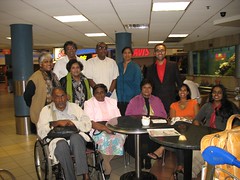 I was very touched to see so many family members there at the airport to see us off, including Auntie Carol and my cousin Christine, as well as Harold, Auntie Joan, Auntie Saroj, Uncle Raymond, and cousin Thanusha, and Uncle Cyril and Auntie Kogi. Everyone was very loving, and I felt very loved... I ended up wearing a red shirt and a striped suit. I had brought the suit for my birthday, but had left it in my mum's closet, and totally forgotten about it. I only discovered it again on our last day, so, I opted to wear it, even though it wasn't the most sensible choice.
I was very touched to see so many family members there at the airport to see us off, including Auntie Carol and my cousin Christine, as well as Harold, Auntie Joan, Auntie Saroj, Uncle Raymond, and cousin Thanusha, and Uncle Cyril and Auntie Kogi. Everyone was very loving, and I felt very loved... I ended up wearing a red shirt and a striped suit. I had brought the suit for my birthday, but had left it in my mum's closet, and totally forgotten about it. I only discovered it again on our last day, so, I opted to wear it, even though it wasn't the most sensible choice.
I am very glad to be safely back in Canada, and I am looking forward to going out to BC on Sunday, so visit briefly with my friend Daryl, and then see my Dad for a week. And, of course, I am very much looking forward to seeing Sharmeen! The family in South Africa is very curious to meet her, and of course, they are encouraging us to get married! I told them I've got my best people working on it!
 I was very touched to see so many family members there at the airport to see us off, including Auntie Carol and my cousin Christine, as well as Harold, Auntie Joan, Auntie Saroj, Uncle Raymond, and cousin Thanusha, and Uncle Cyril and Auntie Kogi. Everyone was very loving, and I felt very loved... I ended up wearing a red shirt and a striped suit. I had brought the suit for my birthday, but had left it in my mum's closet, and totally forgotten about it. I only discovered it again on our last day, so, I opted to wear it, even though it wasn't the most sensible choice.
I was very touched to see so many family members there at the airport to see us off, including Auntie Carol and my cousin Christine, as well as Harold, Auntie Joan, Auntie Saroj, Uncle Raymond, and cousin Thanusha, and Uncle Cyril and Auntie Kogi. Everyone was very loving, and I felt very loved... I ended up wearing a red shirt and a striped suit. I had brought the suit for my birthday, but had left it in my mum's closet, and totally forgotten about it. I only discovered it again on our last day, so, I opted to wear it, even though it wasn't the most sensible choice.I am very glad to be safely back in Canada, and I am looking forward to going out to BC on Sunday, so visit briefly with my friend Daryl, and then see my Dad for a week. And, of course, I am very much looking forward to seeing Sharmeen! The family in South Africa is very curious to meet her, and of course, they are encouraging us to get married! I told them I've got my best people working on it!
Thursday, June 7, 2007
Back to Canada
Mum and I fly to Johannesberg today at 5:40 pm, and from there on to London, and then Toronto. We've had a good trip, although this has definitely been more of a working holiday, than a vacation. The family is coming over soon for a last send-off, and we'll be incommunicado until our arrival in Canada on Friday night. Wish us a safe flight!
Wednesday, June 6, 2007
Last Full Day...
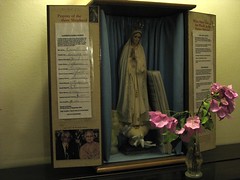 Tomorrow Mum and I fly home... it's been another full day. Right now Mum is cleaning the fridge... We started the day by saying goodbye to "all my ladies," including Thanusha, Auntie Saroj, and Christine. Later, we had lunch & a lively discussion with Pat Poovalingam and his wife Shakuntala. And in the evening, we had dinner with Julienne and some of her family. She has 9 children, a whole bunch of grandchildren, and one great grandchild, and she's younger than my mum! She told us the story about Auntie Sylvie's death in Sri Lanka: what an ordeal! Julienne went to accompany Auntie Sylvie to Uncle Claude's Diamond Jubilee in Sri Lanka - he had spent 60 years as a priest. Soon after, she died of a heart attack in Candy. We got a group photo in front of Auntie Sylvie's old piano to remember her. You can see all the photos here.
Tomorrow Mum and I fly home... it's been another full day. Right now Mum is cleaning the fridge... We started the day by saying goodbye to "all my ladies," including Thanusha, Auntie Saroj, and Christine. Later, we had lunch & a lively discussion with Pat Poovalingam and his wife Shakuntala. And in the evening, we had dinner with Julienne and some of her family. She has 9 children, a whole bunch of grandchildren, and one great grandchild, and she's younger than my mum! She told us the story about Auntie Sylvie's death in Sri Lanka: what an ordeal! Julienne went to accompany Auntie Sylvie to Uncle Claude's Diamond Jubilee in Sri Lanka - he had spent 60 years as a priest. Soon after, she died of a heart attack in Candy. We got a group photo in front of Auntie Sylvie's old piano to remember her. You can see all the photos here.
Tuesday, June 5, 2007
Long day for a Tuesday
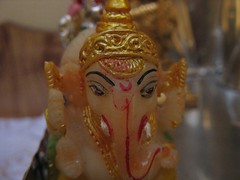 Mum and I are winding down our trip, and so there is a rush on to fit in everyone we can. Today we visited 4 different sets of people, which was pretty hectic. We started the day at Dr. Lulu Mahabeer's place. She was good enough to serve us a lovely lunch, and we had a nice social visit. After, Leslie Peters picked us up, and we got to visit with him, and my Mum's school chum Emily, and their son Melvin, who is a jazz pianist. We had a nice time, and then made our way over to visit with Herbie and Betty Govinden. There, we discussed Satyagraha, and I pulled out the stops for an interview. And then, finally, Jackie Nagan, and her husband Aubrey picked us up, and we had dinner and discussed the Naidoo side of the family. Jackie is my second cousin, which means that her grandmother was my grandfather Naidoo's sister. What a day! You can see all the pictures here. Frankly, I'll be glad once we are safely back in Canada. I'm looking forward to just relaxing for a bit with Dad.
Mum and I are winding down our trip, and so there is a rush on to fit in everyone we can. Today we visited 4 different sets of people, which was pretty hectic. We started the day at Dr. Lulu Mahabeer's place. She was good enough to serve us a lovely lunch, and we had a nice social visit. After, Leslie Peters picked us up, and we got to visit with him, and my Mum's school chum Emily, and their son Melvin, who is a jazz pianist. We had a nice time, and then made our way over to visit with Herbie and Betty Govinden. There, we discussed Satyagraha, and I pulled out the stops for an interview. And then, finally, Jackie Nagan, and her husband Aubrey picked us up, and we had dinner and discussed the Naidoo side of the family. Jackie is my second cousin, which means that her grandmother was my grandfather Naidoo's sister. What a day! You can see all the pictures here. Frankly, I'll be glad once we are safely back in Canada. I'm looking forward to just relaxing for a bit with Dad.
Satya = Truth
My commitment to and understanding of the principle of Satya continues to deepen. This from Gregg's "The Power of Non-Violence":
"In the persuasion of non-violent resistance, there must be not only gentleness and love but also truth. All human beings make mistakes. Adherence to truth requires public admission of our mistakes. If, out of pride or ignorance, we wait until others show up our error, then people mistrust both our ability and our honesty. But public confession of faults promotes trust because it shows: (1) a realiztion of one's likeness to all other people in respect to liability to error, hence a sense of human unity; (2) humility; (3) honesty; (4) disinterestedness towards one's personal fortunes; (5) willingness to pay the price of mistakes; hence (6) a sense of responsibility; (7) courage; (8) a revival of intelligence after a lapse into stupidity; and therefore (9) worthiness to be given another opportunity; and (10) the realization of an intellectual prerequisite to progress. When I have made a mistake in arithmetic, I cannot correct it and get the right answer until after I have admitted, at least to myself, that I made a mistake. Thus, in the moral realm, frankness and humility are modes of intelligence."
"In the persuasion of non-violent resistance, there must be not only gentleness and love but also truth. All human beings make mistakes. Adherence to truth requires public admission of our mistakes. If, out of pride or ignorance, we wait until others show up our error, then people mistrust both our ability and our honesty. But public confession of faults promotes trust because it shows: (1) a realiztion of one's likeness to all other people in respect to liability to error, hence a sense of human unity; (2) humility; (3) honesty; (4) disinterestedness towards one's personal fortunes; (5) willingness to pay the price of mistakes; hence (6) a sense of responsibility; (7) courage; (8) a revival of intelligence after a lapse into stupidity; and therefore (9) worthiness to be given another opportunity; and (10) the realization of an intellectual prerequisite to progress. When I have made a mistake in arithmetic, I cannot correct it and get the right answer until after I have admitted, at least to myself, that I made a mistake. Thus, in the moral realm, frankness and humility are modes of intelligence."
Comments
I know that Sharmeen, Rosemary, and Natasha read this blog, as well as perhaps Harold, and Christina and Michele and Dad more sporadically. However, it appears that you are not in the habit of leaving comments. Did you know that you can click on the "comments" button below, and leave a comment, thought, or reaction? Did you know that you can also read other people's comments? That's what the Friday Five, etc., are all about!
Today is Tuesday. We've got a full day of interviews - actually, Mum has optimistically lined up 4 interviews today (when realistically I think we can only do two). Somehow, the plan is to bend time, and get them all done. We're going to have to do that, because I've only got 4 DV tapes on me at the moment. There will be an opportunity to get more tapes tomorrow, but for today, those 4 tapes will have to do.
Today is Tuesday. We've got a full day of interviews - actually, Mum has optimistically lined up 4 interviews today (when realistically I think we can only do two). Somehow, the plan is to bend time, and get them all done. We're going to have to do that, because I've only got 4 DV tapes on me at the moment. There will be an opportunity to get more tapes tomorrow, but for today, those 4 tapes will have to do.
Monday, June 4, 2007
Monday Monday Monday
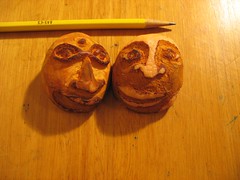 Phew... what a day... I started today carving avocado pits into heads. I was introduced to this practice by my Haida friend Gwaai. He's been carving avocado pits for years, and we used them to make the action figures for the Haida Raid movie. These heads look kind of "african," which I think makes sense, given that I'm on the continent. I was reasonably pleased with my first attempt at this.
Phew... what a day... I started today carving avocado pits into heads. I was introduced to this practice by my Haida friend Gwaai. He's been carving avocado pits for years, and we used them to make the action figures for the Haida Raid movie. These heads look kind of "african," which I think makes sense, given that I'm on the continent. I was reasonably pleased with my first attempt at this. I also was pleased to see the article that Devi Rajab wrote in today's Mercury, about some of the ideas that I've discussed in this blog, about non-violent approaches to South Africa's violent crime problems, etc.. I was delighted to read the article, and I felt Devi did a good job communicating some of the key ideas in a concise manner. I will be interested to see what type of reaction she gets. It also makes me think that it'd be interested in writing a grant to develop a Satyagraha-based approach to this problem, possibly with Canadian funding. I'll give it some thought, and then contact Ila Gandhi at Satyagraha.org.za.
 We had lunch at the revolving restaurant, which gave us ample wonderful views. I went up onto the roof, which was super windy, and snapped a bunch of pics and shot some video.
We had lunch at the revolving restaurant, which gave us ample wonderful views. I went up onto the roof, which was super windy, and snapped a bunch of pics and shot some video. Later, we visited Uncle Raymond & Auntie Saroj's place, and then, spent some time at Auntie Joan's. I took a bunch of pictures of old photographs (see below). It gives you pause, when you see how young and good looking everybody was. My advice: take lots of pictures now! You can see all of today's pictures here. And check out these pics from back in the day: Auntie Joan and Mamma, when they were both young, and a picture of Mamma as a young child with her brother David, her Mum and Auntie May (I think), and a woman I don't know in between...
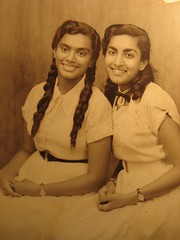
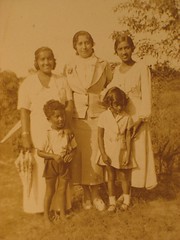
Sunday, June 3, 2007
Birthday Weekend
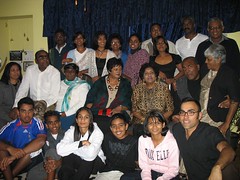 Well, we've definitely celebrated my birthday in style. In addition to the party on my power day, my Auntie Carol organized a big birthday bash for me at my cousin Josie's place. We had a lovely time, with my Uncles Raymond and Cyril in attendance, along with Aunties Joan, Carol, and of course Mum, in addition to all the other aunties and uncles and cousins, etc. We even managed to get in a Skype with Christina, Vijay, and baby Jayanti in NYC. You can see all the pics here. I am pleased that I managed to get everyone to line up like this!
Well, we've definitely celebrated my birthday in style. In addition to the party on my power day, my Auntie Carol organized a big birthday bash for me at my cousin Josie's place. We had a lovely time, with my Uncles Raymond and Cyril in attendance, along with Aunties Joan, Carol, and of course Mum, in addition to all the other aunties and uncles and cousins, etc. We even managed to get in a Skype with Christina, Vijay, and baby Jayanti in NYC. You can see all the pics here. I am pleased that I managed to get everyone to line up like this!Yesterday, Mum and I did an interview with Fatima Meer. She's not in the best health these days, but she has been a boon to the community. She has written numerous books, including:
 * Portrait of Indian South Africans
* Portrait of Indian South Africans* Apprenticeship of a Mahatma
* Race and Suicide in South Africa
* Documents of Indentured Labour,
* The South African Gandhi: The Speeches and Writings of M.K. Gandhi
* Resistance in the Townships
* Apartheid our Picture
* Passive Resistance.
* She also authored Higher than Hope, the first authorized biography of Nelson Mandela, which was translated into 13 languages.
As Mamma is fond of saying, "Fatima Meer deserves a medal!"
After, Hester came by and picked us up and we had a lovely meal and discussion with her and Harold. Harold gave us a wood carving that Father Leo Gabriel had done for his Uncle Vincent Lawrence. That was really sweet of him. We talked about all sorts of stories and memories, and I got to hear more about Justin, my second cousin who died under mysterious circumstances in Arizona. I identify with him, because he sounded like a seeker. I'll need to visit Rosemary some time in the UK to learn more.
Saturday, June 2, 2007
Social Entrepreneurship
I've been in touch with Devi Rajab, after interviewing her for the Lawrence Project. She's decided to write an article in tomorrow's paper about applying Satyagraha to the problem of violent crime here in South Africa. Success will require a sustained effort, and innovative approaches to the use of Satyagraha in this context. I also think it will be important to start small, and build on small successes, while also adhering to Gandhian principles of self-reliance. One way to do this is via Social entrepreneurship. I've just been looking at the Canadian Center for Social Entrepreneurship in Alberta, as well as the Enterprising Non-Profits guide, for ideas on how to build sustainable businesses that also transform society for the better.
How can we support the good in violent criminals and help them transform into Satyagrahis? Is this even possible? This transformation will require an attitude of compassion, and a willingness to see and support the good in others. When I was in Canada, I heard about a socially proactive business that was explicitly started to provide jobs for ex-convicts who were returning to society. Even in Canada, no one wants to hire a criminal. So, the group started a construction company with experienced formen and managers, and hired the ex-cons as labor. The ex-convicts got a job, and skills training, while also working to create houses for people in the larger economy. As I think about what I want to do next, I think I really want to find a way to marry the innovation and viability of entrepreneurship with the good works of social and environmental activism. It seems to be, this is really what the world needs right now.
How can we support the good in violent criminals and help them transform into Satyagrahis? Is this even possible? This transformation will require an attitude of compassion, and a willingness to see and support the good in others. When I was in Canada, I heard about a socially proactive business that was explicitly started to provide jobs for ex-convicts who were returning to society. Even in Canada, no one wants to hire a criminal. So, the group started a construction company with experienced formen and managers, and hired the ex-cons as labor. The ex-convicts got a job, and skills training, while also working to create houses for people in the larger economy. As I think about what I want to do next, I think I really want to find a way to marry the innovation and viability of entrepreneurship with the good works of social and environmental activism. It seems to be, this is really what the world needs right now.
Friday, June 1, 2007
Friday Five
 Today Mum and I had a lovely interview with Dr. Devi Rajab. I really enjoyed meeting her, and her mother, who is also an artist (and adorable!). You can see some of the pictures here. There are also a few pics from my trip to Sibaya with Thobeka, and a pic or two from the Symphony (thanks to Nichelyn for taking us!).
Today Mum and I had a lovely interview with Dr. Devi Rajab. I really enjoyed meeting her, and her mother, who is also an artist (and adorable!). You can see some of the pictures here. There are also a few pics from my trip to Sibaya with Thobeka, and a pic or two from the Symphony (thanks to Nichelyn for taking us!). We've been here in South Africa for over 3 weeks now, with just 6 more days to go. Of course we've got a big party planned for Sunday, thanks to my Auntie Carol. Otherwise, Mum and I are going through the trunk of old pictures, documenting everything, and we've still got a few more interviews to shoot. We're doing our best to wrap things up.
However, my thoughts have already turned to home... so, this week's Friday Five is all about home and family:
1. Where is home for you?
2. Are you at home now, or away?
3. What do you miss about home when you are away?
4. Who are your family?
5. Can you ever really leave home?
Subscribe to:
Posts (Atom)